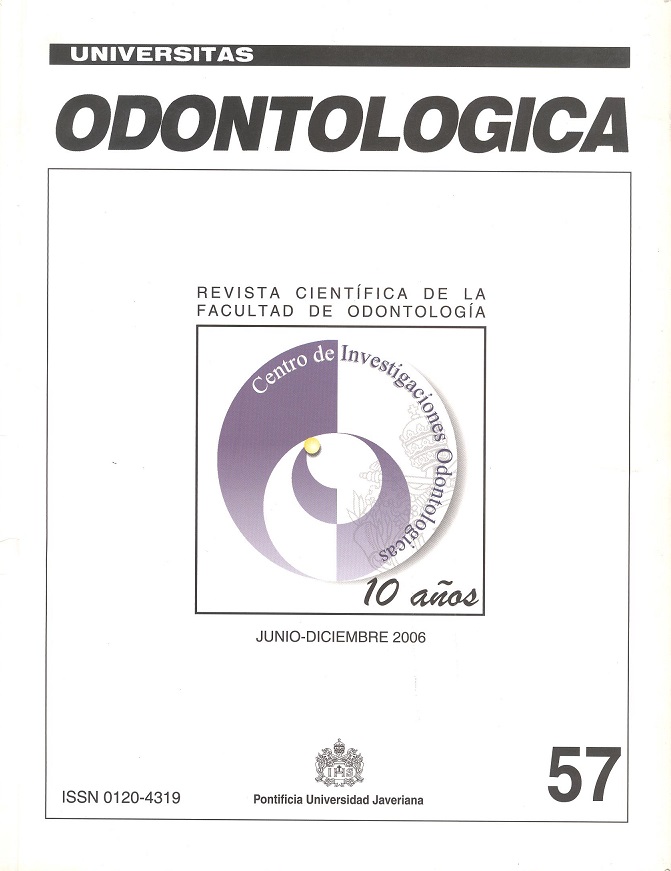Resumo
Mutaciones en los genes que participanen el desarrollo del esmalte dental, como amelogenina (AMEL) y enamelina (ENAM) entre otras, causan amelogénesis imperfecta (AI). OBJETIVO: establecer las mutaciones presentes en el gen AMEL y el modo deherencia en una familia colombiana con AI. MATERIALES Y MÉTODOS: se realizó un pedigree de la familia, evaluación clínica y extracción del ADN de sangre periférica a los individuos participantes. La reacción en cadena de la polimerasa (PCR) fue usada para amplificar los 7 exones del gen AMEL en el brazo corto del cromosoma X y análisis de SSCP fueron realizados en los exones 5 y 6. Electroforesis en gel de poliacrilamida al 6% no denaturantes fueron hechas. Para confirmar ausencia o presencia demutaciones se hizo secuenciamiento de los productos de PCR de los 7 exones. RESULTADOS: el análisis del pedigree mostró un mecanismo de herencia ligado a X y el fenotipo dental observado en los probandos, correspondió a un defecto de tipo hipoplásico. No se identificaron mutaciones en los siete exones del gen amelogenina. CONCLUSIÓN: esta condición tiene gran heterogeneidad genética y posiblemente el fenotipo encontrado esté más relacionado con mutaciones en otros genes concernientes a la formación del esmalte.
Mutations of the genes which participate in the enamel development such as amelogenine (AMEL) and enameline (ENAM) among others cause Amelogenesis Imperfecta (A.I). OBJECTIVES: Establish the mutations present in the AMEL gene and the means of inheritage in a Colombian family with A.I. MATERIALS AND METHODS: family pedigree, clinical evaluation and peripheric DNA genomic blood extraction was performed to each of the participating individuals. PCR was used to amplify the 7 exons of the amelogenine gene in the short arm of the X chromosome. SSCP analysis was carried out in the 5 and 6 exons. Gel electrophoresis with non denaturalizing 6% polyacrilamide were carried out to confirm the presence or absence of mutations in the AMEL gene, after which the sequencing of the 7 exon PCR products was performed. RESULTS: the pedigree analysis showed an X heritage linked mechanism. The dental phenotype observed in the proband corresponded to a hypoplastic type defect. There were no identified mutations at a molecular level in the 7 exons of the amelogenine gene. CONCLUSION: this condition has great genetic heterogeneticity and possibly the phenotype found is more related with mutations in other genes linked to the formation of the dental enamel.
Uchida T, Tanabe Y, Fukae M, Shimizu M. Immunocytochemical and immunochemical detection of a 32 kDa nonamelogenin and related proteins in porcine tooth germs. Arch Histol Cytol 1991; 54: 527-38.
Robinson C, Shore RC, Kirkham J, Stonehouse NJ. Extracellular processing of enamel matrix proteins and the control of crystal growth. J Biol Buccale 1990; 18: 355-61.
Witkop CJ. Amelogenesis imperfecta, dentinogenesis imperfecta and dentin dysplasia revisited: problems in classification. J Oral Pathol 1989; 17: 547-53.
Online Mendelian Inheritance in Man, http://
www.ncbi.nlm.nih/entrez/OMIM.
Lench NJ, Brook AH. DNA Diagnosis of linked amelogenesis imperfecta (AIHI). Journal of Oral Pathology and Medicine 1997: 26: 135-7.
Crawford PJM, Aldred MJ. X-linked amelogenesis imperfecta. Presentation of two Kindreds and a review of the literature. Oral Surg Oral Med Oral Pathol 1992; 73: 445-9.
Hart PS, Hart TC, Simmer JP. Wrigth JT. Establishment of a nomenclature for X-linked amelogenesis imperfecta. Arch Oral Biol 2002; 9: 19-23.
Lagerstrom-Fermer M. Nilson M, Backman B et al. Amelogenin signal peptide mutation: Correlation between mutations in the amelogenin gene (AMGX) and manifestations of X-linked amelogenesis imperfecta. Genomics 1995; B26: B159-62.
Witkop CJ Jr. Partial expression of sex-linked recessive amelogenesis imperfecta in females compatible with the lyon hipotesis. Oral Surg Oral Med Oral Pathol 1967:23: 174-82.
Lyon MF. Gene action in the X-chromosome of the mouse mus musculus L. Nature 1961; 190: 372-3.
Hart PS, Hart TC, Gibson C, Wright JT. Mutational analysis of X-linked amelogenesis imperfecta in multiple families. Arch Oral Biol 2000; 47: 255-60.
Witkop CJ Jr. Amelogenesis imperfecta, dentinogenesis imperfecta and dentin dysplasia revisited: problems in classification. J Oral Pathol 1989; 17: 547-53.
Wright JT, Hart PS, Aldred MJ, Seow K, Crawford PJ, Hong SP et al. Relationship of phenotype and genotype in X-linked amelogenesis imperfecta. Connect Tisssue Res 2003; 44: 72-8.
Ravassipour DB, Hart S, Hart TC, Ritter AV et al. Unique enamel phenotype associated with amelogenin gene (AMELX) codon 41 point mutation. J Dent. Res 2000; 79:1476-81.
Este periódico científico está registrado sob a licença Creative Commons Atribuição 4.0 Internacional. Portanto, este trabalho pode ser reproduzido, distribuído e comunicado publicamente em formato digital, desde que os autores e a Pontifícia Universidade Javeriana sejam reconhecidos. Citar, adaptar, transformar, autoarquivar, republicar e criar novas obras a partir do material é permitido para qualquer finalidade (mesmo comercial), desde que a autoria seja devidamente reconhecida, um link para o trabalho original seja fornecido e quaisquer alterações sejam indicadas. A Pontifícia Universidade Javeriana não detém os direitos sobre os trabalhos publicados, e o conteúdo é de exclusiva responsabilidade dos autores, que mantêm seus direitos morais, intelectuais, de privacidade e de publicidade.


